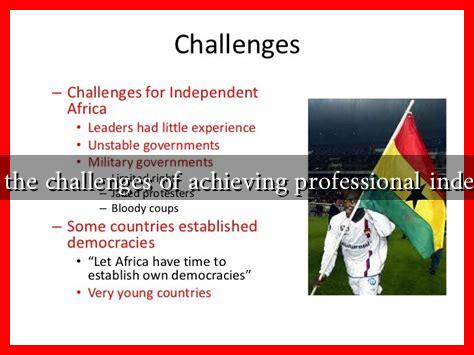-
Table of Contents
What are the Challenges of Achieving Professional Independence?
Professional independence is a goal for many individuals across various fields, from freelancers and entrepreneurs to corporate professionals seeking autonomy in their careers. However, achieving this independence is fraught with challenges that can hinder progress and create obstacles. This article explores the multifaceted challenges of attaining professional independence, providing insights and examples to illustrate these hurdles.
Understanding Professional Independence
Professional independence refers to the ability to make decisions and take actions in one’s career without undue influence from external parties. This can include financial independence, the freedom to choose projects, and the ability to set one’s own schedule. While the allure of professional independence is strong, the path to achieving it is often complex.
Key Challenges to Professional Independence
Several challenges can impede the journey toward professional independence. Here are some of the most significant:
- Financial Constraints: Many individuals face financial barriers that limit their ability to pursue independent work. For instance, freelancers often struggle with inconsistent income, making it difficult to invest in their businesses or sustain themselves during lean periods.
- Lack of Support Systems: Professional independence can be isolating. Without a network of mentors, peers, or collaborators, individuals may find it challenging to navigate their careers effectively. A study by the Freelancers Union found that 63% of freelancers feel lonely in their work.
- Market Competition: In many fields, competition is fierce. Professionals seeking independence must differentiate themselves and build a personal brand, which can be daunting. For example, in the tech industry, the rapid pace of innovation means that professionals must continuously upskill to remain relevant.
- Regulatory and Legal Barriers: Certain professions are subject to strict regulations that can limit independence. For instance, healthcare professionals often face licensing requirements that can restrict their ability to practice independently.
- Time Management: Achieving independence often requires effective time management skills. Many individuals struggle to balance their professional responsibilities with personal commitments, leading to burnout and decreased productivity.
Case Studies: Real-World Examples
To better understand these challenges, consider the following case studies:
- Freelance Graphic Designer: Sarah, a freelance graphic designer, initially enjoyed the freedom of choosing her projects. However, she soon faced financial instability due to inconsistent client work. To overcome this, she began networking with other freelancers and joined online platforms like Upwork to secure more consistent income.
- Startup Founder: John launched a tech startup with a vision for independence. However, he quickly encountered regulatory hurdles that delayed his product launch. By seeking legal advice and understanding the regulatory landscape, he was able to navigate these challenges and successfully launch his business.
Strategies for Overcoming Challenges
While the challenges of achieving professional independence can be daunting, there are strategies that individuals can employ to overcome them:
- Build a Strong Network: Connecting with like-minded professionals can provide support, resources, and opportunities. Attend industry events, join professional organizations, and leverage social media platforms like LinkedIn.
- Develop Financial Literacy: Understanding financial management is crucial for freelancers and entrepreneurs. Consider taking courses on budgeting, accounting, and investment to build a solid financial foundation.
- Continuous Learning: Stay updated with industry trends and continuously develop your skills. Online platforms like Coursera offer courses that can help you remain competitive.
- Seek Mentorship: Finding a mentor can provide invaluable guidance and support. Mentors can help navigate challenges and offer insights based on their experiences.
Conclusion
Achieving professional independence is a rewarding yet challenging journey. Financial constraints, lack of support, market competition, regulatory barriers, and time management issues can all pose significant obstacles. However, by building a strong network, developing financial literacy, committing to continuous learning, and seeking mentorship, individuals can navigate these challenges effectively. Ultimately, the pursuit of professional independence is not just about autonomy; it is about creating a fulfilling and sustainable career that aligns with one’s values and aspirations.

